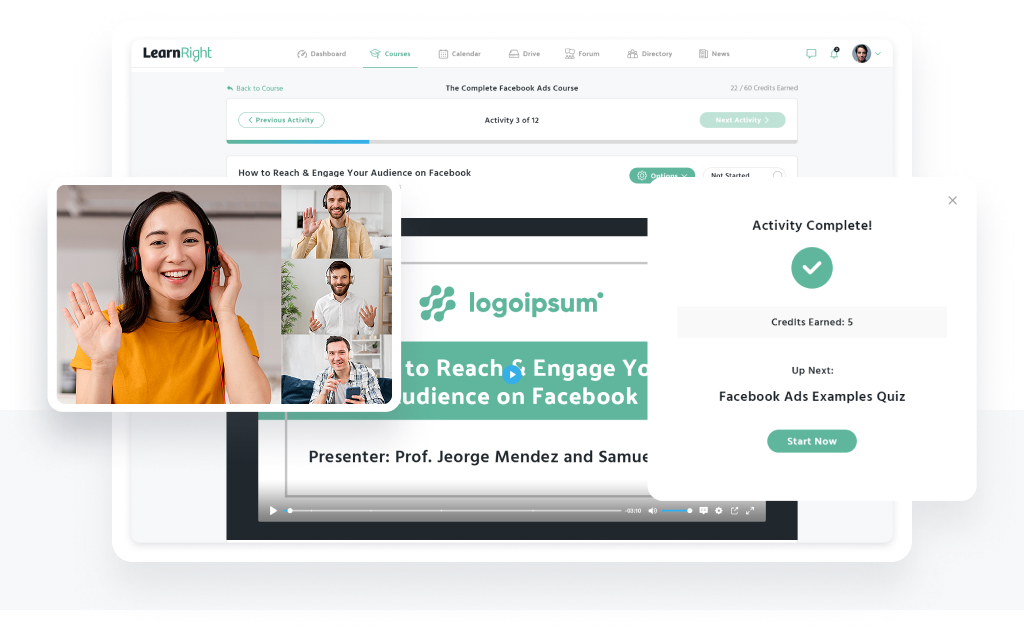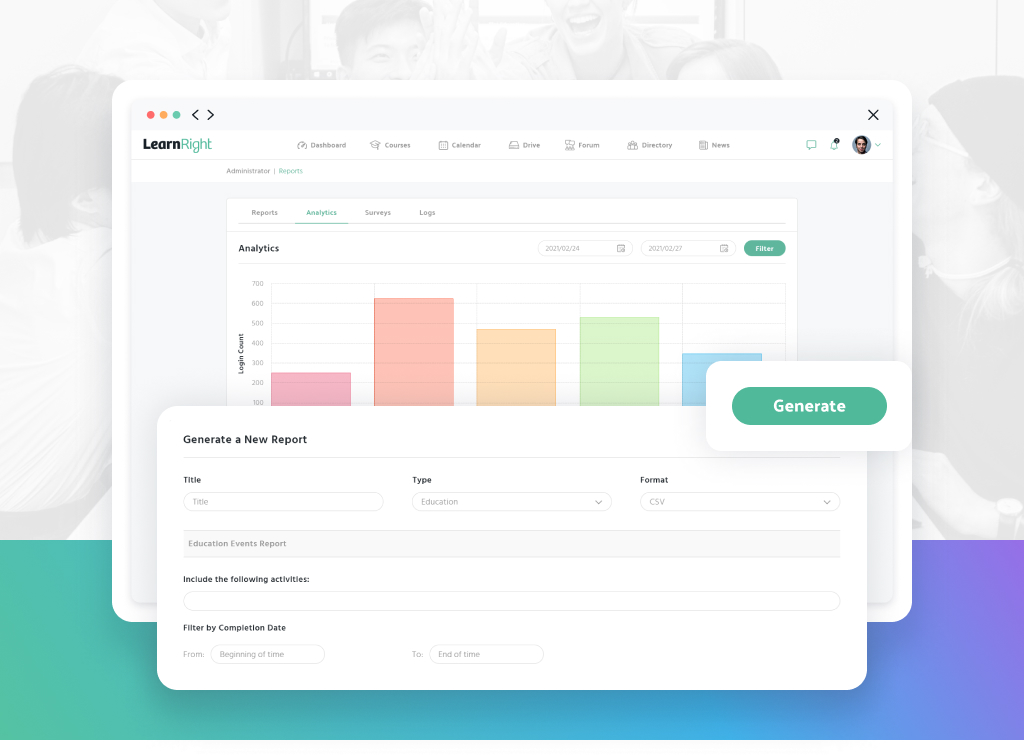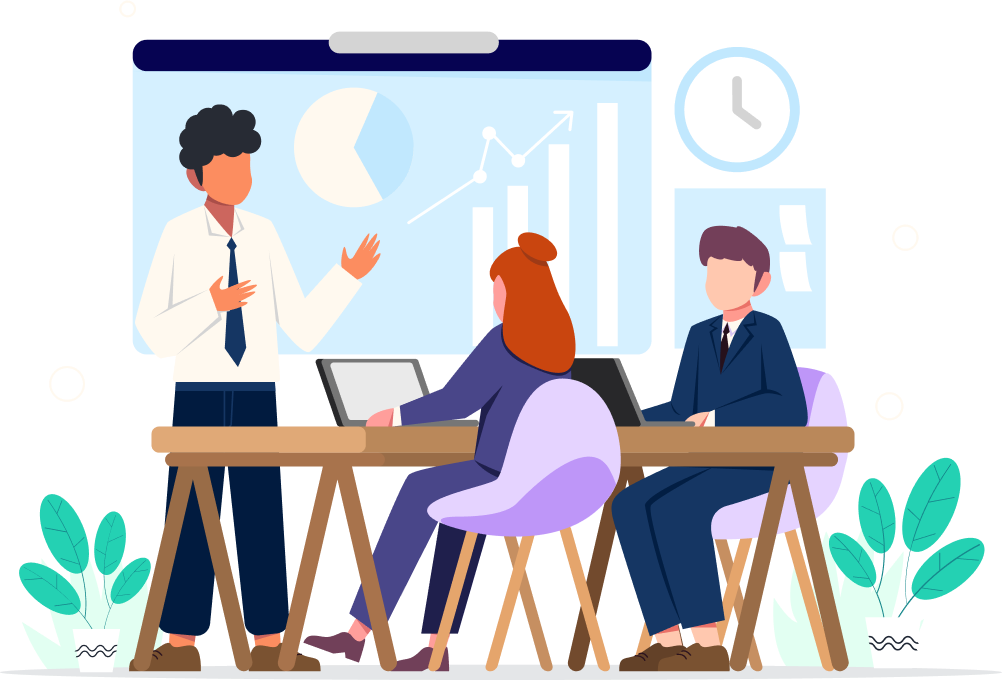If your employees aren’t learning new skills, you risk losing them. That’s not an LMS-shilling scare tactic; that’s a truth backed by hard numbers.
Take this one, for example: 41% of employees polled said they’d leave their employers if they didn’t receive training in the next year. Here’s another: 93% of employees said they’d stay longer with a company that invests in their career development.
And for the “all-business” business owners, there’s this one: companies that offer training programs enjoy salaries that are 218% higher than those without, an indicator that the company’s profits are higher (and, probably, that employees are happier).
Upskilling makes good business sense, and there’s never been a better time to make it part of your growth strategy. We’ve put together this upskilling guide to show you how to get started.
How is upskilling different from employee training?

Upskilling programs focus specifically on improving employees current skill level so they can hit their next career mark sooner. If they’re entry level, upskilling shows them how to get that first raise or secure their first promotion. If they’re more experienced, upskilling arms them with advanced skills that prepare them for managerial roles with a higher level of responsibility.
Upskilling is different from employee training because it doesn’t just show your staff how to do their current jobs better, it prepares them for their next job. It’s an investment in your employees’ careers, and by making it, you’re increasing the likelihood that those careers will remain within your company.
AI’s changing the skills employees need

Employees sense an AI-driven shift in the jobs market, and 58% of them believe AI will change their job roles within the next 5 years. They want to upskill to keep themselves relevant as job markets change, and training delivers what employees – and your company – need to stay competitive.
Rock-solid reasons to invest in continuous learning via upskilling

There are almost endless stats on the benefits of investing in upskilling programs. We’ll share a few, but it’s the psychology behind upskilling that explains why it’s a touchstone issue for employees.
Employee development keeps them happy
Upskilling helps you boost your employee engagement. For staff who’ve mastered the basics, it delivers the next exciting challenge and gives them more to discover at your company beyond the humdrum of their current role.
If you allow employees to become bored at work, their engagement will slip, showing cracks in their performance and leading to poor customer outcomes. As time goes on, bored employees will begin to look outside your organization for a more interesting career path. But training adds a bit of spice to employees’ workday. It keeps them interested in their role and encourages them to show up and get involved. Gallup even found that offering opportunities to learn cut absenteeism by 44%.
Training programs translate to profits
Companies that engage their employees with training enjoy 17% higher productivity, which leads to organizational growth. There’s no mystery here – training keeps employees interested in their jobs and improves their skills, so they work harder and produce more. More work = more money for your company. Business case closed.
Training creates an environment of lifelong learning
It may sound corny, but people still respond to a company culture of learning. As employees expand their skills, they expand their minds, making room for big ideas and innovative thinking. Training inspires skills growth that translates to personal growth. It breeds above-and-beyond work ethics and team-player mindsets.
Take a pulse and find your skills gaps

When you’re starting upskilling programs from scratch, the task can feel daunting. Where do you start? What new skills do your employees need?
You’ll find answers in 3 places: with the HR team, your managers, and the employees themselves.
Start with HR
A dynamic HR team should be keeping an eye on how workforce skills are evolving both at your company and within your industry. Ask your team where they project skills shortages within the next 5 years. They’ll also be able to share trends they’ve seen in employee evaluations – these will tell you how managers and employees view their current competencies.
Talk to managers
Interview your management team to hear whether they’ve noticed a distinct lack of skills in any particular area, or if employees seem hungry for more skills in another.
Poll your employees
Finally, poll employees to see exactly what they feel comfortable doing and where they need guidance.
Not only will you discover topics you might not have guessed, you’ll see which employees are thinking about how to do their job better and advance their careers. Those go-getters will have great ideas for upskilling and will jump at the chance to improve their career prospects.
Prioritize skills gaps and set goals

Your chats with employees and HR might leave you with a long list of skills gaps to plug, and that can be overwhelming.
Take a deep breath, get a cup of coffee, and sit down with your list again. This time, you’re here to prioritize.
Recall which skills and concerns were mentioned most often. Pinpoint the trends and prioritize the top 5 for this year’s training programs. Rome wasn’t built in a day, and your development programs won’t be, either. It’s best to focus on a few thoughtfully-designed and well-executed training programs than to try to address every skills gap at once.
Then, set goals for each of your modules – and the metrics you’ll use to measure whether your training’s been a success. Consider tracking participation and completion numbers, test and quiz grades, and feedback on the training (more on that below).
If you don’t have an LMS, now’s the time to get one

Upskilling programs take serious organizational skills and are most successful when you can track results and adjust your trainings. We won’t say it’s impossible to provide upskilling programs without a learning management system (LMS), but it’s close.
Choosing an LMS to deliver trainings will allow you to:
- Organize your upskilling programs into learning journeys.
- Pace your training more thoughtfully and assign learners to journeys strategically.
- Track progress and step in when a learner is struggling.
- Gather all the data generated into reports to showcase your successes and tweak your upskilling programs for improvements.
Vary your training delivery types

Workforce training keeps employees engaged, but if the training itself is boring, they won’t stay engaged for long.
Vary the way you deliver your training by mixing in several different training types like slide decks for information that’s best learned via the written word, or live webinars for data that tends to be a bit boring and could use a human touch to keep it entertaining.
For skills that just need a hands-on approach, schedule on-the-job training that coincides with an online course, and quizzes or content revisions to see whether the hands-on training has stuck. That way, you’ll know if employees need to revisit their on-the-job training or whether they’re ready to move on to the next skill.
An LMS lets you deliver every conceivable type of online course, from videos to slide decks, live webinars to instructor-led training. It’s a great way to ensure everyone gets the same training experience, and it allows other learners to browse upskilling topics to improve their individual skills, too.
Use breaks and microlearning to create a healthy pace

Don’t hit employees too hard with a flood of upskilling training. Yes, they want to learn new skills, but even sought-after training’s not enjoyable if it’s too intense. Add breaks into longer courses and encourage learners to wait a week or so before starting the next course in their learning journey to help curtail burnout.
Microlearning courses can help keep the pace interesting without letting employees’ interest in learning go cold. Place very brief modules between longer ones in your learning journey so that employees stay engaged without getting overwhelmed by too much content.
Schedule tests and quizzes at key milestones

Don’t assume everyone’s learning at the same pace. Your learners are individuals with different learning styles, interests, and abilities. An LMS allows you to schedule quizzes and tests at milestones in your training, so use those features to check how your learners are faring. If anyone’s falling behind, it’s best to know soon so you can step in and give them help rather than pushing on when they don’t understand the basics.
Always follow up for employee feedback

We talk about “learning outcomes” a lot, but it’s worth re-calibrating that phrase every once in a while: the learning outcome that matters most is whether your learners learned.
Did they successfully master that skill that will help them take on a new role? Are they more prepared than before for the challenges you’re giving them next?
Learner feedback gives you the answers. Always ask for feedback via a poll or survey. You can send a follow-up email asking for feedback, or if you’re using an LMS, you can build feedback collection directly into the course or learning journey.
Want to know how to get helpful feedback? Read these “4 Training Feedback Examples + 11 Training Feedback Questions You Should Ask“.
Measure and report for next year’s upskill training programs

With feedback from your poll or survey and the metrics you’ve measured throughout the upskilling learning journey in your LMS, it’s time to see whether you’ve hit your goals for each training.
Gather your metrics and see what they tell you. What percentage of eligible employees took your training? Of those, how many told you it improved their skills or gave them new skills for the next job? Measure feedback and participation against test and quiz scores, completion rates, and overall progress rates for a comprehensive picture of how your upskilling programs served your learners.
A good LMS will deliver insightful (and downloadable) reports you can share with stakeholders like HR and management. Together, you can see whether your workforce is growing into upskilled dynamos who’ll build their careers within your positive, learning-driven organizational culture.
Ready to create better courses, organize your learning journeys, and offer employees the upskilling opportunities they crave? Then you’re ready for LearnRight! Get a free demo and see how choosing a brilliant LMS can revolutionize your training.







